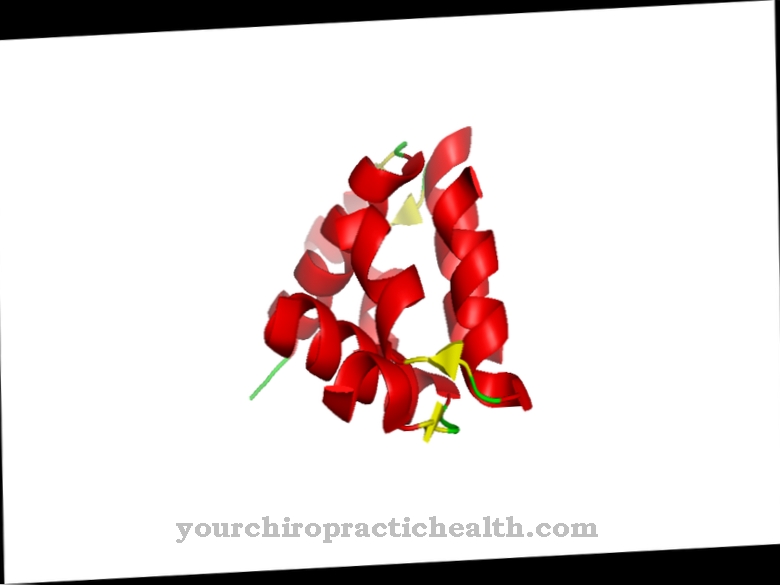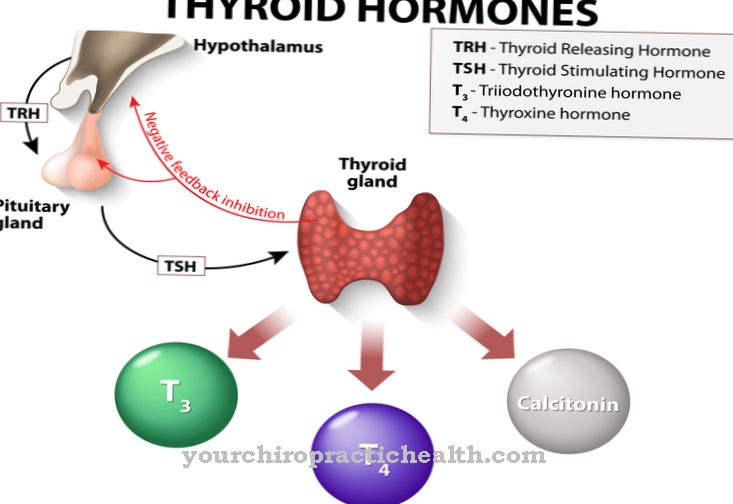Low density lipoproteins form one of several lipoprotein classes that are able to take up cholesterol and other water-insoluble lipophilic substances and transport them in the blood serum.
The LDLs take on the task of taking up cholesterol at its place of origin - mainly the liver - and bringing it to the target tissue. In contrast, high-density lipoproteins have the task of absorbing excess cholesterol in the tissue and transporting it back to the liver for further use.
What are Low Density Lipoproteins?
Low density lipoproteins (LDL) consist about half of transport proteins and the other half of cholesterol, cholesterol esters, triglycerides and phospholipids. The protein component consists mainly of apolipoproteins, also called apoproteins, which are also synthesized by the liver and intestinal epithelium of the small intestine.
The apoproteins each have a hydrophilic group which, together with the phospholipids, ensure that LDLs, like the other lipoprotein classes, can also be dissolved in the serum in order to perform their transport function. Lipoproteins with a density of 1.019 to 1.062 g / ml are included in the class of LDLs. The molecules with a diameter of 18 to 25 nanometers reach a molar mass of 550 kDa. The main function of LDL is to absorb the cholesterol produced by the body itself in the liver or in the intestinal mucosa at the point of origin and to transport it to the target tissue.
An unusually high concentration of LDLs in the serum with a simultaneous low concentration of HDLs is considered to be of health concern. It is assumed that in these cases too much cholesterol is stored in the vessel walls because there are too few options for removal.
Function, effect & tasks
Cholesterol has a variety of important functions in the body. It is part of all cell membranes and ensures their functionality. This also applies to vascular epithelia, whose cell membranes have to withstand special requirements.
In addition, cholesterol makes an important contribution to fat metabolism and is the starting material for the synthesis of bile acids and vitamin D as well as for the production of some steroid hormones such as estrogen, testosterone and the stress hormone cortisol. Many brain functions also depend on an adequate supply of cholesterol. For example, a decreased level of cholesterol in the brain correlates with decreased cognitive and other performance. For decades, a high cholesterol level in the blood plasma was judged to be fundamentally harmful, because atherosclerotic changes in the vessels, which are caused by so-called plaques, contain cholesterol. The deposits arise due to excessive storage of cholesterol and are actually used to repair tiny hairline cracks and other damage in the membranes of the vascular epithelia.
Since it is not the cholesterol itself that can be measured when determining cholesterol, but only the concentration of lipoproteins, LDLs in particular were generally suspected of causing atherosclerotic changes in blood vessels. In its function as a transport protein, its task is to take up cholesterol at its point of origin in the liver or, to a lesser extent, in the intestinal mucosa of the small intestine, to carry it to the target tissue and to release it there. This also applies in the case of initiated repair mechanisms in the vessels. Normally, excess cholesterol is absorbed by HDLs in the target tissue, transported back to the liver and further metabolized in the liver, i.e. broken down or recycled.
Education, occurrence, properties & optimal values
The concentration of the individual lipoprotein fractions in the serum is largely dependent on a genetic component and on lifestyle habits with regard to exercise intensity. The influence of nutrition is only weakly pronounced because the vast majority of lipoproteins do not come directly from food, but are synthesized by the body itself from simple basic building blocks, mainly in the liver and in the intestinal mucous membrane of the small intestine.
The so-called mevalonate pathway plays a role in biosynthesis. DMAPP (dimethylallyl pyrophosphate) is produced via the mevalonate route, which is the starting substance for the synthesis of lipoproteins. From DMAPP, LDL and the other lipoprotein fractions are formed in an 18-step reaction chain. In recent years, assumptions about health risks with regard to cholesterol levels - based on the USA - have shifted significantly. While in the past a high LDL value per se was considered dangerous to health, the focus is now on the ratio of LDL to HDL.
A ratio above four is considered a clear risk factor for the occurrence of atherosclerotic vascular changes, CHD, myocardial infarction and stroke. Irrespective of the LDL level, an HDL concentration of over 60 mg / dl is considered favorable, while an HDL level of below 40 mg / dl is generally classified as risky. An LDL concentration in serum of 70 to 180 mg / dl is the reference range for women and men alike in Germany.
Diseases & Disorders
The main dangers in connection with low density lipoproteins are too low or too high a concentration in the serum, whereby the risks cannot be derived from the concentration of the LDL alone, but must be seen in relation to the HDL level and in relation to the lipoprotein , which has a very similar structure to LDL and seems to have a significant influence on the formation of plaques in the vessels.
Homozygous familial hypercholesterolemia (HoHF), which occurs very rarely with around one case per million inhabitants, is expressed in Ldl concentrations that can reach 600 to 1,000 mg / dl. The genetic metabolic disease shows up in childhood and leads to visible fat lumps in the skin and early onset of arteriosclerosis with all its sequelae. Heterozygous familial hypercholesterolemia (HeHF), on the other hand, has a much milder course, but is relatively common with one case per 500 inhabitants. The symptoms are caused by a genetic disorder of the LDL receptors.





.jpg)






















